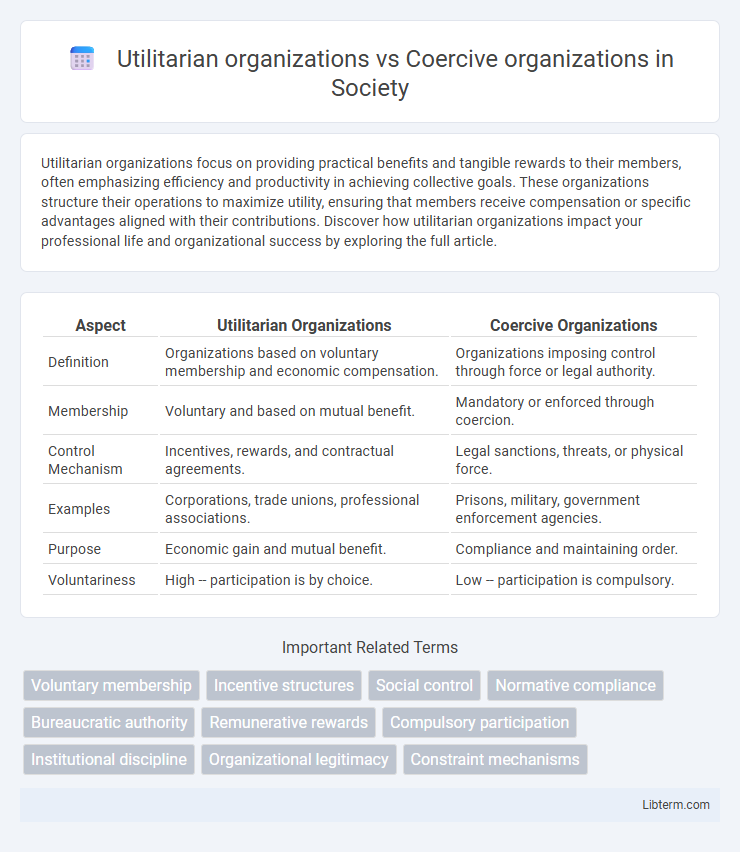Utilitarian organizations focus on providing practical benefits and tangible rewards to their members, often emphasizing efficiency and productivity in achieving collective goals. These organizations structure their operations to maximize utility, ensuring that members receive compensation or specific advantages aligned with their contributions. Discover how utilitarian organizations impact your professional life and organizational success by exploring the full article.
Table of Comparison
| Aspect | Utilitarian Organizations | Coercive Organizations |
|---|---|---|
| Definition | Organizations based on voluntary membership and economic compensation. | Organizations imposing control through force or legal authority. |
| Membership | Voluntary and based on mutual benefit. | Mandatory or enforced through coercion. |
| Control Mechanism | Incentives, rewards, and contractual agreements. | Legal sanctions, threats, or physical force. |
| Examples | Corporations, trade unions, professional associations. | Prisons, military, government enforcement agencies. |
| Purpose | Economic gain and mutual benefit. | Compliance and maintaining order. |
| Voluntariness | High -- participation is by choice. | Low -- participation is compulsory. |
Introduction to Utilitarian and Coercive Organizations
Utilitarian organizations motivate members primarily through tangible rewards such as salaries, benefits, and promotions, focusing on achieving individual goals within a structured framework. Coercive organizations, by contrast, enforce compliance and control through strict rules, regulations, and penalties, often limiting individual freedoms to maintain order and authority. Understanding these distinctions highlights how different organizational structures impact member behavior and overall effectiveness.
Defining Utilitarian Organizations
Utilitarian organizations are entities where membership is based on the tangible benefits and rewards individuals receive, such as wages, salaries, or other economic incentives. These organizations emphasize formal structures and goal-oriented processes to maximize efficiency and productivity. Employees join primarily to achieve specific personal benefits, distinguishing utilitarian organizations from coercive ones, which rely on force or imposed control.
Key Characteristics of Coercive Organizations
Coercive organizations are defined by their reliance on force, compliance, and control to achieve objectives, often using formal sanctions or punishments to enforce rules. These organizations typically operate through hierarchical structures, strict regulations, and limited employee autonomy, emphasizing obedience over voluntary participation. Common examples include prisons, military units, and psychiatric institutions, where authority is maintained through coercion and constrained individual freedoms.
Membership and Participation Differences
Utilitarian organizations rely on voluntary membership driven by material incentives such as salaries or benefits, making participation primarily goal-oriented and performance-based. Coercive organizations enforce mandatory membership through formal regulations, often involving penalties or sanctions, resulting in forced or obligatory participation regardless of individual preference. The key difference lies in the basis of membership consent--utilitarian through voluntary agreement, coercive through imposed control--and the consequent level of active engagement from members.
Goals and Purposes of Each Organization Type
Utilitarian organizations prioritize individual benefits by aligning goals with members' financial or material rewards, such as profit maximization or career advancement. Coercive organizations focus on enforced compliance and control through strict rules and surveillance to achieve institutional stability or social order. The primary purpose of utilitarian organizations is to incentivize participation for mutual gain, while coercive organizations aim to regulate behavior and maintain dominance.
Methods of Control and Compliance
Utilitarian organizations employ formal mechanisms such as rewards, salaries, and benefits to ensure compliance, leveraging economic incentives to motivate employees towards organizational goals. Coercive organizations rely on forceful methods including penalties, sanctions, and threats to maintain control, often enforcing compliance through strict rules and hierarchical authority. These contrasting control methods shape employee behavior by either fostering voluntary participation through tangible benefits or enforcing obedience through authoritative power.
Examples of Utilitarian Organizations
Utilitarian organizations primarily attract members through material rewards, exemplified by corporations like Apple and Google, which offer competitive salaries and benefits to employees. Professional associations such as the American Bar Association also serve as utilitarian organizations by providing career advancement and certification opportunities. These organizations emphasize practical incentives to motivate participation and commitment.
Examples of Coercive Organizations
Coercive organizations enforce compliance through formal rules and sanctions, often relying on authority and control to maintain order. Examples include prisons, military institutions, and totalitarian regimes, where adherence is typically mandatory and resistance is met with punishment. These organizations prioritize obedience and conformity to institutional norms over voluntary cooperation.
Sociological Impacts and Implications
Utilitarian organizations, characterized by voluntary membership and material incentives, foster social integration and individual autonomy, promoting collaborative work environments and economic productivity. Coercive organizations impose control through force or legal authority, often leading to social stratification, limited personal freedom, and resistance or conflict within the social structure. The sociological implications reveal that utilitarian organizations support social cohesion and innovation, whereas coercive organizations may perpetuate power imbalances and institutional rigidity.
Conclusion: Comparing Utilitarian and Coercive Organizations
Utilitarian organizations rely on voluntary membership and incentives like salaries or benefits to motivate participation, fostering cooperative and goal-oriented environments. Coercive organizations compel membership or compliance through force or strict rules, often leading to resistance and reduced autonomy. Comparing the two, utilitarian organizations tend to promote higher employee satisfaction and productivity, while coercive organizations may achieve control but at the cost of motivation and innovation.
Utilitarian organizations Infographic

 libterm.com
libterm.com